Zoom Lens or Prime? 50mm and 55mm
Related: apochromatic, astrophotography, barrel distortion, bokeh, Canon 24-70mm, depth of field, digital sensor, distortion, external articles by Lloyd, field curvature, focusing, How-To, Live View, Nikon 24-70mm, noise, optics, pincushion distortion, T-stop, vignetting, Zeiss, Zeiss 50mm f/1.4 Planar, Zeiss APO, Zeiss Distagon, ZEISS Lenspire, Zeiss Milvus, Zeiss Otus, Zeiss Otus 55mm f/1.4 APO-Distagon, zoom
by Lloyd Chambers, diglloyd.com
Previously I presented the ultra-wide angle and moderate wide angle zoom-vs-prime articles. This is the third in the zoom-vs-prime series, this time with a “normal” lens. On a full-frame 35mm sensor, a normal lens is generally considered something between 40mm and 60mm, with 50mm the nominal choice, that in theory best approximates the field of view of the human eye. I tend to prefer the slightly longer 55mm, because it creates more more of a gap versus the 35mm focal length.
Prime lens = lens having a fixed focal length and thus fixed angle of view, e.g., 50mm.
Zoom lens = lens having a continuous range of focal lengths and angle of view, e.g., 24-70mm.
Prime lenses are specialized instruments, but zooms are versatile tools that have their rightful place in the bag also. The classic 24-70mm zoom range covers the normal lens range handily. For many working pros such as wedding photographers, the 24-70 is a “bread and butter” lens covering a wide variety of shooting needs, with the flexibility of shooting inside where one cannot necessarily back up and/or cannot approach more closely—a necessity if those are typical working conditions. Autofocus might also be a hard requirement for subjects in flux. But when the best possible results are the priority and/or a different look to the images is desired, a prime lens is worth considering.
Accordingly, the premise of this article is that something more or different is desired: more lens speed, more background blur, more sharpness, less objectionable distortion (type or degree), perhaps a different look, and more consistent performance from minimum focus range all the way to infinity focus.
Both Nikon and Canon 24-70mm zooms are impressively improved compared to their predecessors. For this comparison, I’ve pitted the Zeiss Otus 55mm f/1.4 APO-Distagon and Zeiss Milvus 50mm f/1.4 against the latest and best 24-70mm f/2.8 pro zooms from Canon and Nikon. That was a big job—both Nikon and Canon and three lenses each. As shall be seen, both the Nikon 24-70/2.8E ED and Canon 24-70/2.8L II are very good performers at 50/55mm, at least stopped down a bit, but they have their limits.
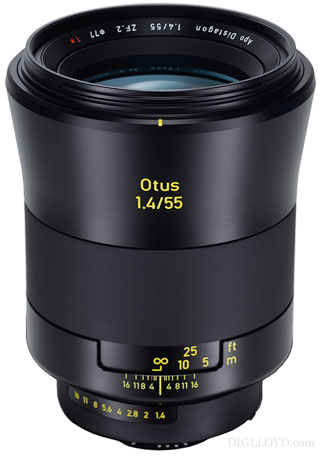
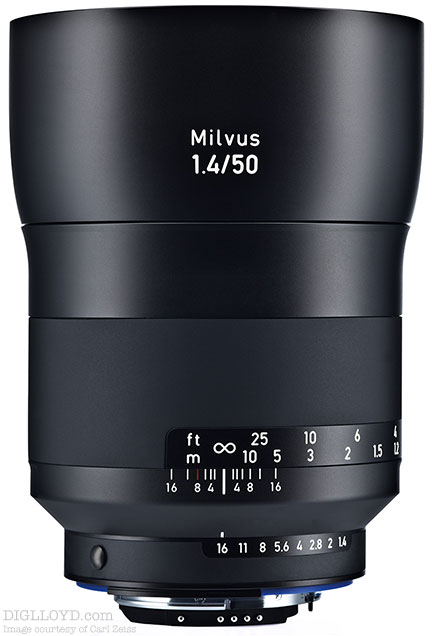
Lens Speed
Lens speed is typically specified in f-stops, which is the ratio of the focal length over the diameter of the entrance pupil, e.g., f/2 for a 50mm lens means a 25mm entrance pupil. But for a wide open lens, f-stop is not a good measure of light-gathering power, for two reasons. First, the center might be close to the nominal f-stop, but typically an f/1.4 lens is T/1.5 even in the center (T-stop means transmission stop), and much darker in the outer zones where the effective aperture due to optical vignetting can be two stops or so less bright. An f/2.8 lens might be more like T/3.2. Sometimesthe f-stop versus T-stop differential is compensated for by the camera. For example, Canon gains-up the wide-open brightness (even in raw) to bring the T-stop to the f-stop value. Real light gathering power (T-stop) matters for low light shooting, where even 1/3 of a stop can improve noise in night scenes significantly, by getting dark tones off pure black to very dark black. And in those corners, the gain might be a whopping two stops, a huge difference.
The key point here is that an an f/1.4 lens stopped down to f/2.8 has banished most of the vignetting, providing much more uniform illumination over the field. By comparison, an f/2.8 lens (zoom or prime) is generally no brighter than T/2.9 (example), even in the center and it its illumination over the frame is much much darker in the outer zones when shot at f/2.8.
Bottom line: an f/1.4 lens shot at f/2.8 offers a much better choice for dusk and night shooting in terms of even illumination across the frame, and avoiding excessive noise in outer zones.
Shown below are four images shot at night when all traces of dusk glow were gone (pure night). An f/1.4 lens gives the option of f/1.4 (substantial vignetting or f/2 (modest vignetting) or f/2.8 (low vignetting) which is also T/2.8. The f/2.8 zoom is unlikely to be faster than T/2.9 (and might be T/3.1 or even T/3.2) and has far more vignetting than the f/1.4 lens shot at f/2.8.
Illuminating: night shooting with f/1.4 prime lens vs f/2.8 zoom
The Canon 5Ds R has (compared to the Nikon D810) very strong noise, so that with night shooting anything one can do to increase exposure can matter a lot to the final image. Key points:
- A high performance lens like the Otus 55/1.4 offers far higher exposure than an f/2.8 zoom, not just at f/1.4, but also at f/2.8 because vignetting is greatly reduced
- At f/2.8, the Otus is T/2.8 but at f/2.8 the zoom is likely about T/3.2 in the center and about T/5.0 in the corners. So the real light gathering powers is substantially greater with the f/1.4 prime at f/2.8 than the f/2.8 pro zoom.
- Focusing with some night scenes (without lights or stars) is much easier at f/1.4 (and more accurate), becuase Live View becomes very noisy in the dark.
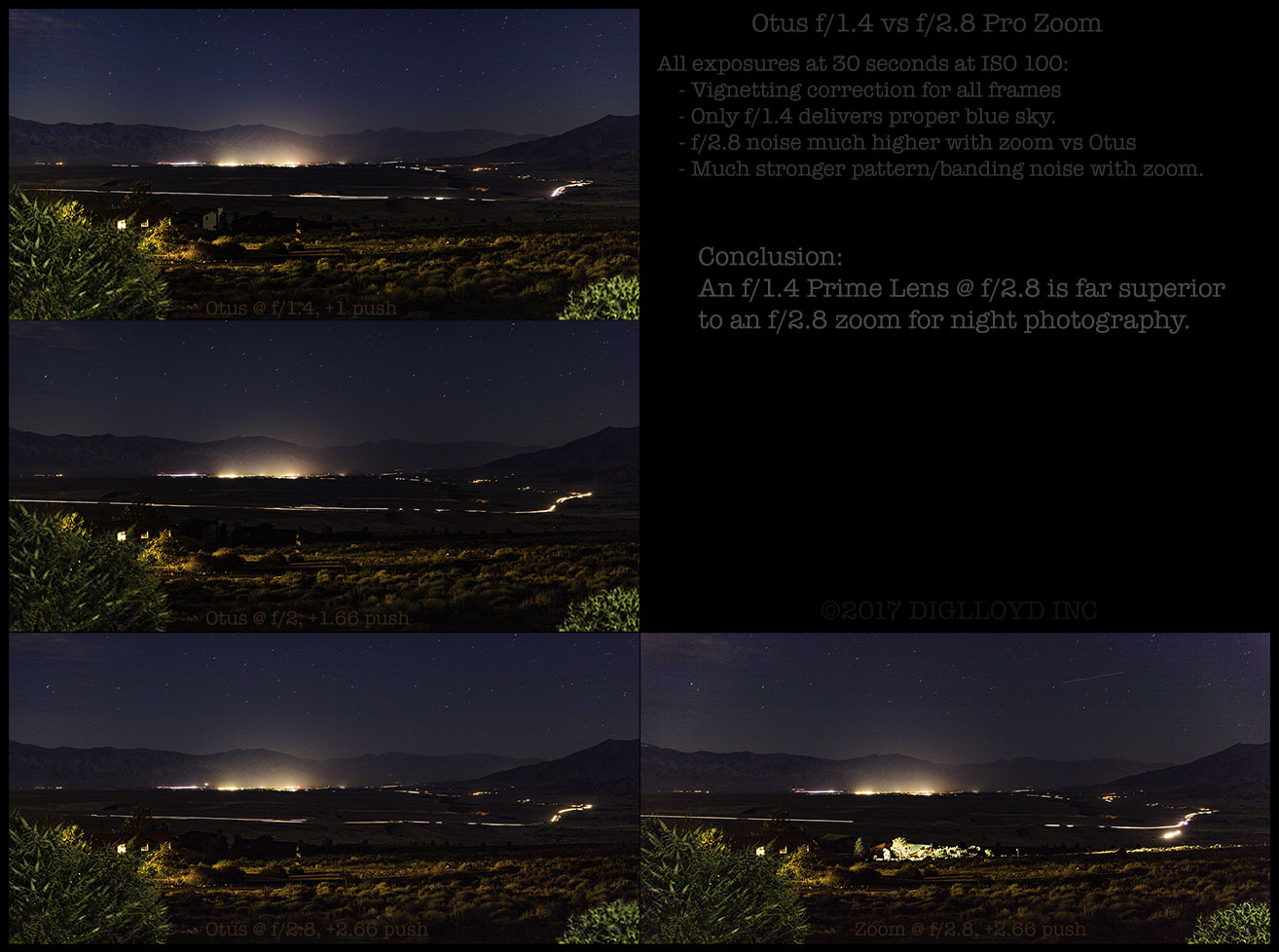
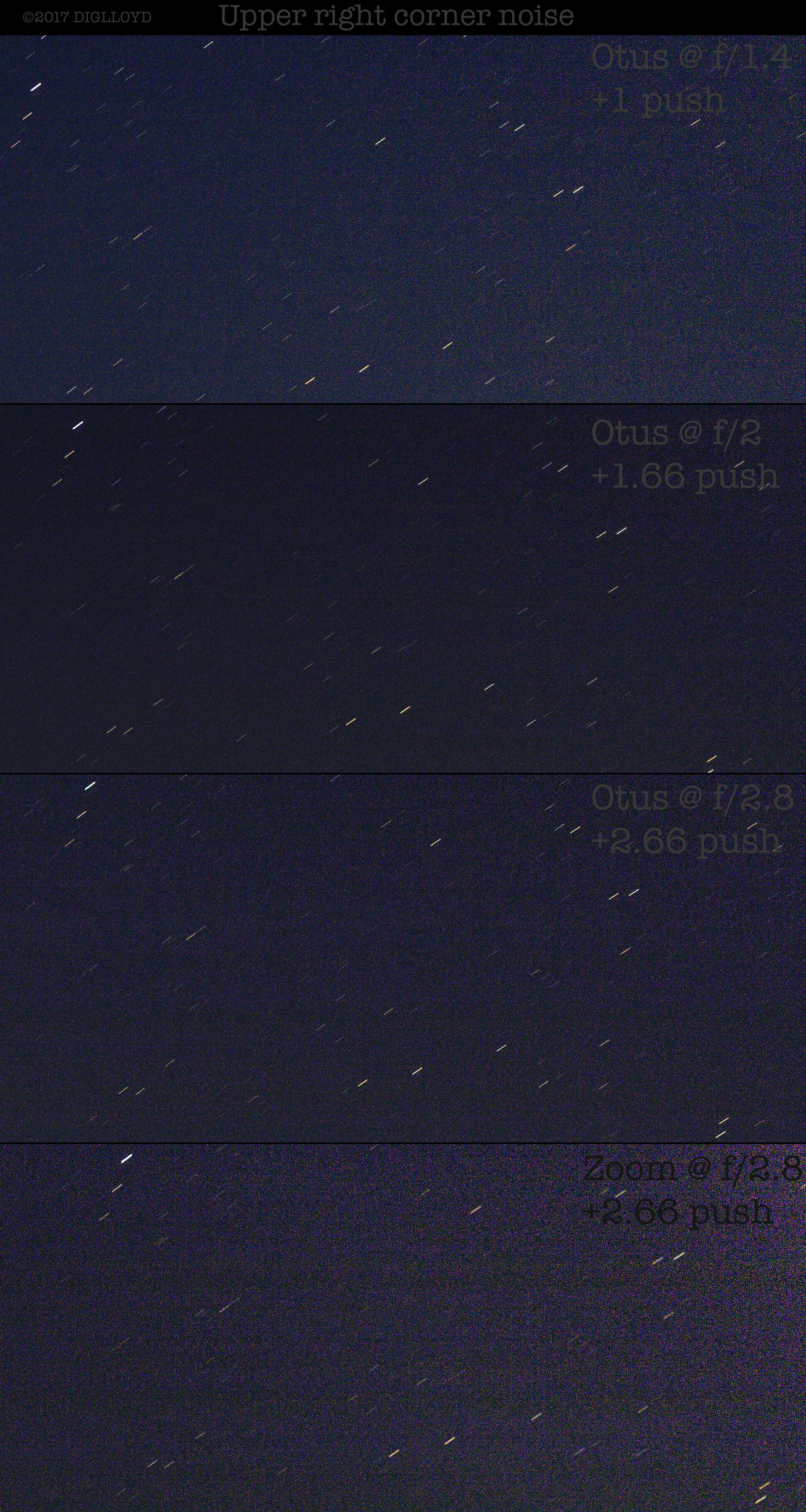
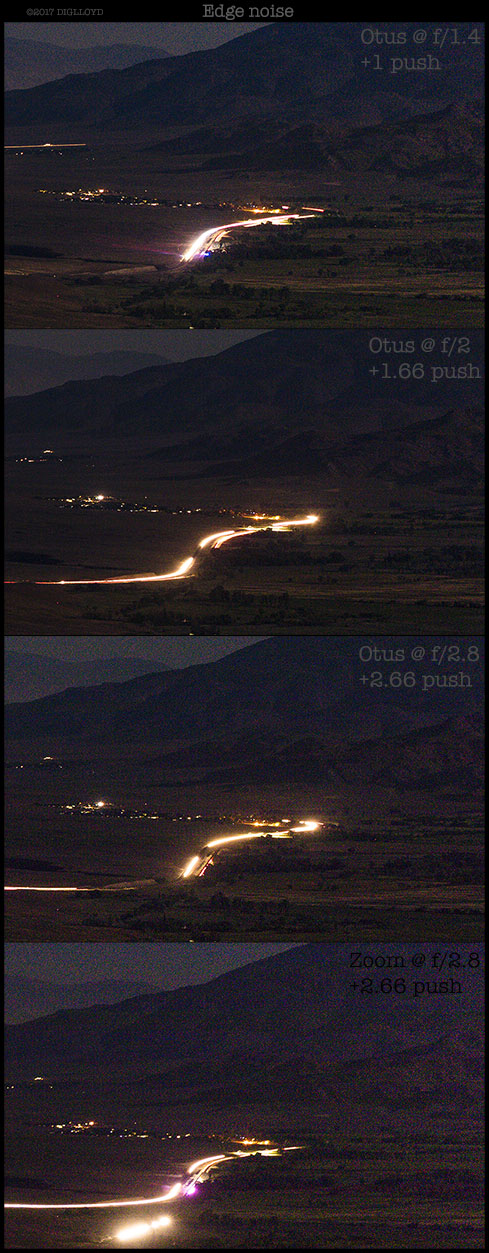
Example: Isolating the subject, bokeh, shutter speed
Shown below are series from f/1.4 through f/5.6 using the Zeiss Otus 55/1.4 APO-Distagon and the Canon 24-70mm f/2.8L II. Both have excellent bokeh at least in this scene. Depending on the shooting style, there are two obvious considerations:
(1) Is the creamy smooth background that of f/1.4 and f/2 that “pops” the subject out of its surrounding of value to one’s own shooting?
(2) Is the possibility of a higher shutter speed without raising ISO necessary?
(3) Does uniform illumination across the frame (minimal vignetting) of an f/1.4 lens at f/2.8 matter for one’s shooting scenarios? The zoom, being wide open, will show darker corners than the f/1.4 prime which at 2 stops down has eliminated most vignetting, as seen below.
As for bokeh, these reduced size images do not tell the whole story: the Otus 55 has smoother shapes in the out of focus areas than the zoom. The difference is not large (the zoom has very good bokeh), but the Otus is just a little more soft in its edge transitions on out of focus speculars.
For the series below the Canon zoom column at right replicates f/2.8 to the right of the f/1.4 and f/2 apertures for the Otus 55/1.4, for ease of comparison. The 3rd row is thus f/2.8 vs f/2.8.
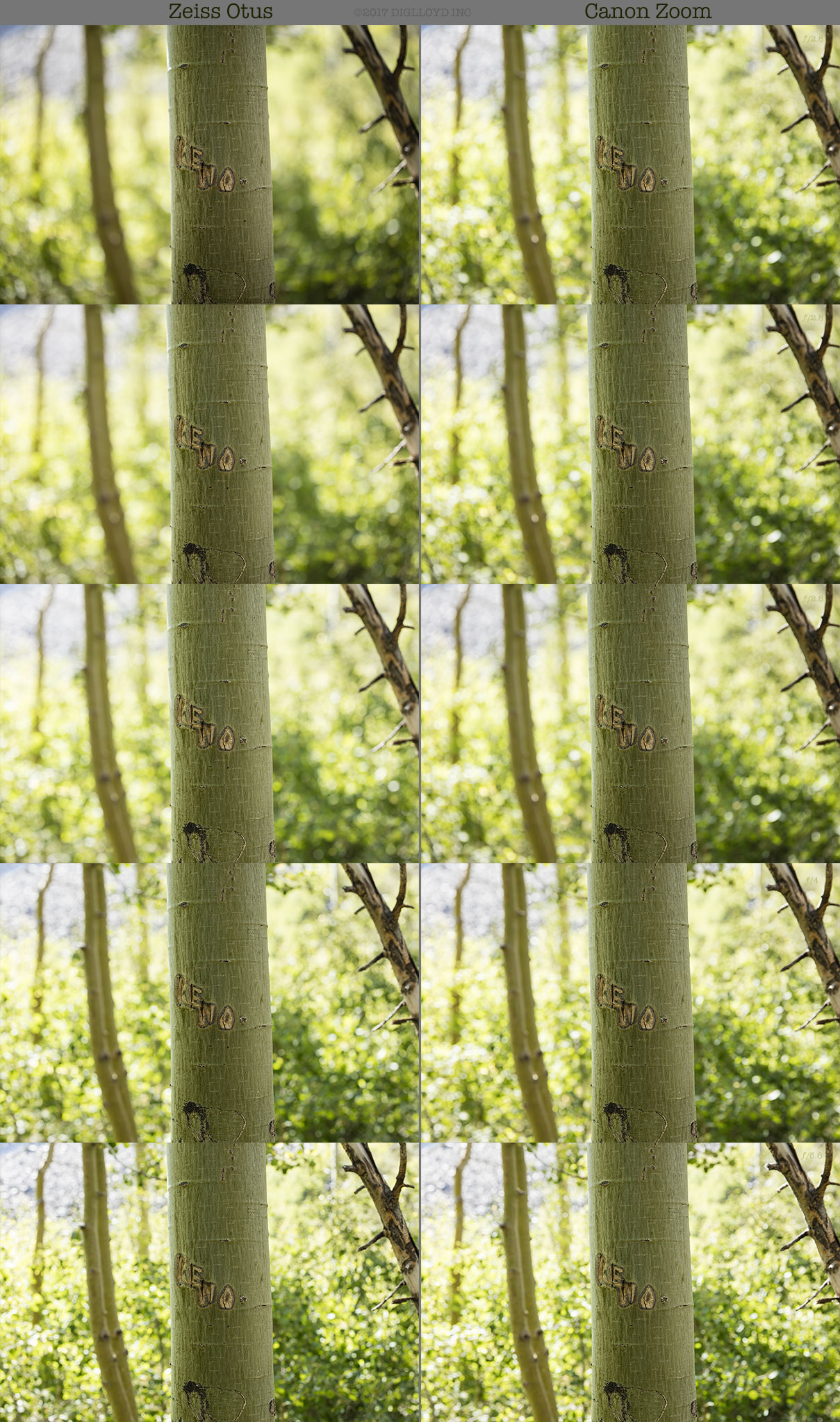
Manual focus vs autofocus
Autofocus can be terrific for many subjects. But manual focus allows fine discimination in the point of focus, which matters at f/1.4 at 50mm (and autofocus systems are not always as precise and accurate as one might hope for). For example, forest scenes may have overlapping trees, and the autofocus system can’t make sense of which is best—a big deal even at quite some distance at wider apertures. Or the focus sensors might not cover the desired location. Ditto for subjects in which the camera cannot prioritize (eyelashes or eyebrows or iris of the eye?)—an autofocus system has its limitations. On the other hand, autofocus is very fast and usually accurate and a time saver and for quick shooting can greatly raise the hit rate.
The Otus 55/1.4 is the best there is with its focusing: cine lens bearings along with a generous focus throw; it has a luxurious feel to it. The Milvus 50/1.4 offers an admirable focusing helicoid (though not cine bearings) but because of its weather sealing is not quite so velvety in operation. Still, it is not bettered in its quality of focus by anything but the Otus. For video work, such focusing characteristics are a real asset.
Example: Sharpness depends on precise focus — focus shift
A typical issue with zoom lenses (and primes too) is focus shift, in which peak sharpness changes position as the lens aperture is changed. Focus shift is one of many tradeoffs made to optimize performance across the zoom range, but it is the bane of high resolution digital sensors. Consider a head and shoulder portrait distance: what happen if the focus shifts just a little and one is shooting at say, f/4, but the camera is focusing at f/2.8? Or (as with Canon AF) focusing effectively as if f/5.6 but shooting at f/2.8? The result will be an image less sharp than the lens can deliver, that is, in the desired place. The greater the resolution of the sensor, the greater the loss in sharpness on a per-pixel basis.
Below, this tree graffiti at actual pixels shows that stopping down from f/2.8 to f/4 with the Canon 24-70 zoom makes f/4 much worse than f/2.8. Except that it is better on the more distant edge of the tree trunk—the focus has shifted rearward signification.. If that were an eye, instead of a sharp iris a blurred iris results with focus somewhere back in the eyeball! Focus was done with Live View at f/2.8. If conventional AF were used (not Live View), the Canon phase-detect autofocus system “sees” at f/5.6, and thus the reverse effect is likely: blur when shooting at f/2.8 with focus too close. Hence some of the confusion on lens adjustment—lens adjustment cannot properly deal with focus shift. The good news for Nikon users is that more recent models appear to compensate for focus shift.
In the actual-pixels image below near center, observe how the fine detail goes blurry at f/4 even as the more distant left side of the tree trunk becomes razor sharp. This is rearward focus shift. Though it is a minor shift, it makes a difference for something like a portrait (eyes). This finding was confirmed several times, repeatedly delivering the same result (and with different subjects). The focus shift might not be present at distance (or might be)—the point is that it this sort of thing can make it hard to obtain peak performance, particularly on the 50 megapixel Canon 5Ds R. I deem focus shift an unacceptable optical design tradeoff with high resolution digital, at least in a prime lens.
Be sure to view at actual pixels; scaled images will make it somewhat less obvious.

Below, the Zeiss Otus does not shift focus at all even from f/1.4 through f/4, a remarkable feat for an f/1.4 lens (ditto for the Milvus 50/1.4). Shown below are f/2.8 to f/4. Stopping down merely extends depth of field, just as one would hope for, thus guaranteeing peak performance where focused.
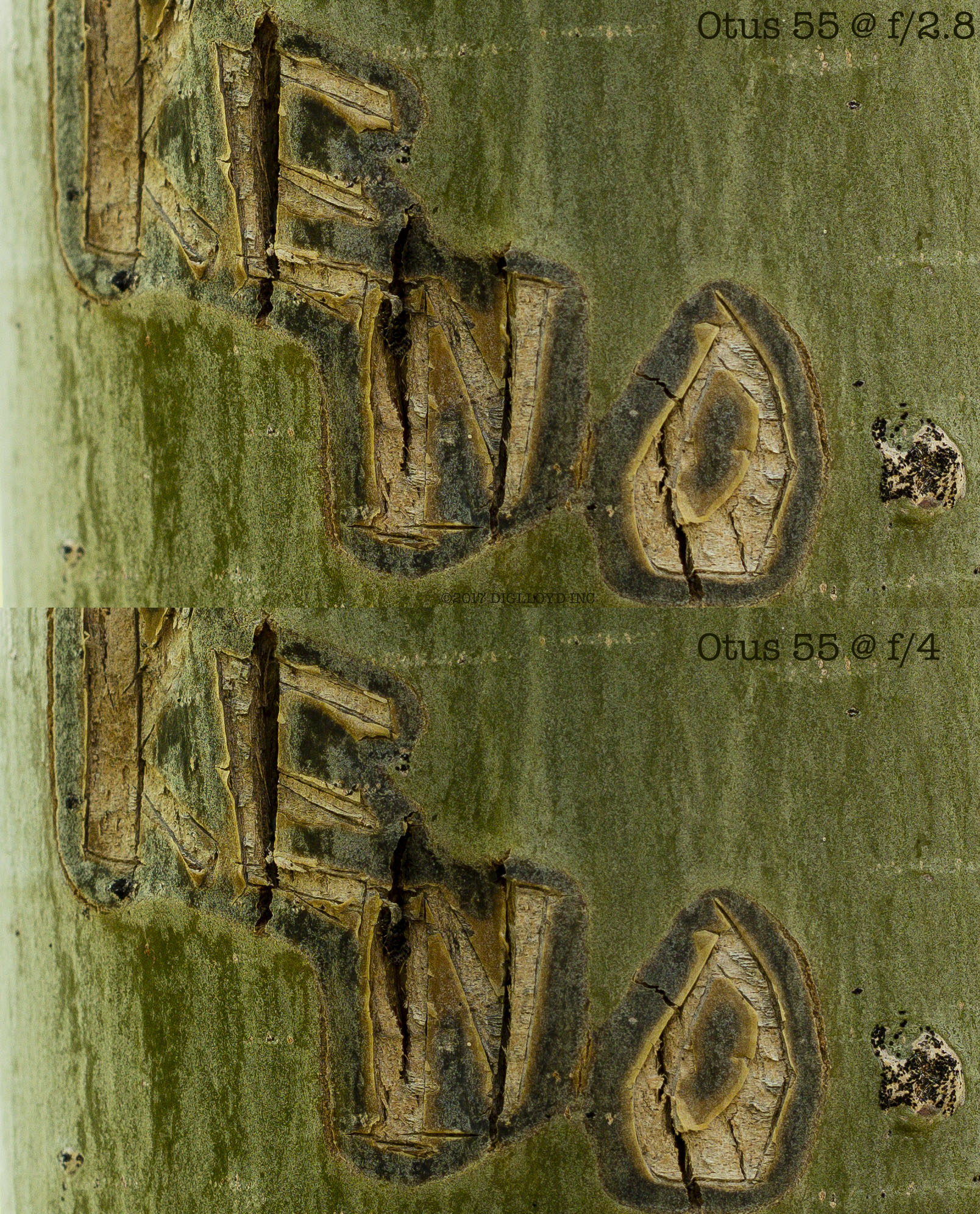
Distortion
Optical distortion, which alters the shape of the image versus reality, should not be confused with pespective “distortion” which is the inverse square law for light.
Zoom lenses invariably have barrel distortion at the wide end (bowing out), and pincushion distortion (bowing in) at the middle and long end. Prime lenses have distortion also, and generally speaking, an f/1.4 prime tends to have more distortion than an f/2 or f/2.8 or f/4 prime lens—distortion is one of the many tradeoffs in optical design. The latest trends in optical design by many vendors tend to allow what in my view is far too much distortion including outrageous distortion (“funhouse distortion”) dealt with in software correction.
There is also the subjective aspect of distortion. To my sensibilities, barrel distortion is much preferable to pincushion distortion—whether it is architecture or horizons or faces, barrel distortion is much more acceptable to my eye; it looks more natural. Similarly, I consider barrel distortion preferable to wave-type distortion (wave-type distortion is barrel distortion reversing to pincushion).
When photographing natural features (or man-made objects), in some cases it may be important to represent them as closely as possible to reality; see for example the syncline image in some of my Death Valley snapshots. In such cases, use an ultra-low distortion lens, like the Zeiss Milvus 85/1.4 or the Zeiss Milvus 100mm f/2M if a longer focal length than the Otus 55 is needed. Note also that zooms tend to increase their distortion at close range.
The Otus 55/1.4 has extremely low distortion for a f/1.4 normal lens—about 0.9% barrel distortion and only about 0.5% to the long frame edge (superb). The Milvus 50/1.4 has about 1.6% barrel distortion and only about 1.1% to long frame edge, which is still quite low for a 50mm lens. Both of these lense are a distinct improvement over the Zeiss ZF.2/ZE 50/1.4 Planar, which has 2% distortion and about 1.4% to long frame edge.
The Canon 24-70/2.8L II zoom at 55mm appears to have about 2.5% pincushion distortion, but there is a key difference: the greatest correction occurs in the central part of the frame, and because the distortion is bowing inwards, the pixels have to be stretched apart outwards—each pixel has to become more than one pixel. This damages micro contrast the most in the most crucial area of the frame, the central 2/3.
Shown below are uncorrected and corrected images. The greatest distortion is the Canon 24-70 zoom at 55mm, but it is low enough to not be bothersome for a complex arrangement like this.

About the Comparisons
I shot many more series than shown here; that is the way I cross-check my results. Between lens foibles such as optical symmetry and field curvature, and focusing meticulously, my patience was put to the test also: 2-way comparisons done right are challenging enough, but 3-way is not a task I approach eagerly.
When doing 3-way comparisons, there is no time to make use of the best light (dawn or dusk) because it changes far too quickly. Ditto for rapid-fire creative shots and skies with big beautiful clouds that can radically change the landscape via shadow patterns. Accordingly, these comparisons used conditions in which the lighting was constant, or nearly so.
Another factor is composition: shooting a scene at a uniform distance offers less insight. Better are surfaces and slopes that recede at an angle or curve away so as to yield insight into lens behavior such as field curvature or focus shift. Those two considerations were a key factor in choosing these particular examples.
It is my view that f/2.8 through f/5.6 are particularly important apertures, hence I’ve chosen those two apertures to present here, with f/2.8 of the zoom competing against the 2-stops-down primes—highly relevant for shooting at f/2.8 and a reason to consider a prime versus shooting an f/2.8 zoom wide open. At f/2.8, f/1.4 primes are already close to optimal whereas an f/2.8 zoom is wide open and not at its best. Aperture f/5.6 gives the zoom a fair chance to show its mettle; if it is not already looking great by f/5.6 then it is rare that more stopping down more improves the core quality behavior—depth of field will increase at f/8 and f/11 thus overcoming field curvature and symmetry issues, but micro contrast starts to drop at f/8. Thus the pairs at f/2.8 and f/5.6.
See the discussion of field curvature in Focusing Zeiss DSLR Lenses For Peak Performance, PART ONE: The Challenges. Field curvature tends to be more of an issue with a zoom, making it necessary to stop down much more, even for something like a group of people.
The problem with showing even relatively large images (2592 across) is that by reducing from full size, the differences become much harder to see. See the actual pixels crops.
Images should be viewed at actual pixels. Differences are best seen in the actual-pixels crops.
Example: Huge Boulder in Tenaya Creek (Nikon D810)
With the Otus 55/1.4, aperture f/2.8 is little different from f/5.6 aside from depth of field. Ditto for the Milvus 50/1.4. The Nikon 24-70/2.8E zoom struggles in all outer zones and delivers less real depth of field near to far, as examination of the full-resolution images shows.
By “real depth of field” I mean the zone of sharpness near-to-far in a real image as compared to theoretical depth of field one might find in a chart; real lenses generally never “get there” in the outer zones in particular. Real depth of field can and does differ between lenses in significant ways. The Otus 55/1.4 is particularly strong at delivering a deep near-to-far “bulb” of sharpness over the central 2/3 of the frame and the Milvus 50/1.4 is nearly as good. Examining images at full resolution taking full measure of all areas of the frame leads to a “total sharpness” assessment. See the crops.
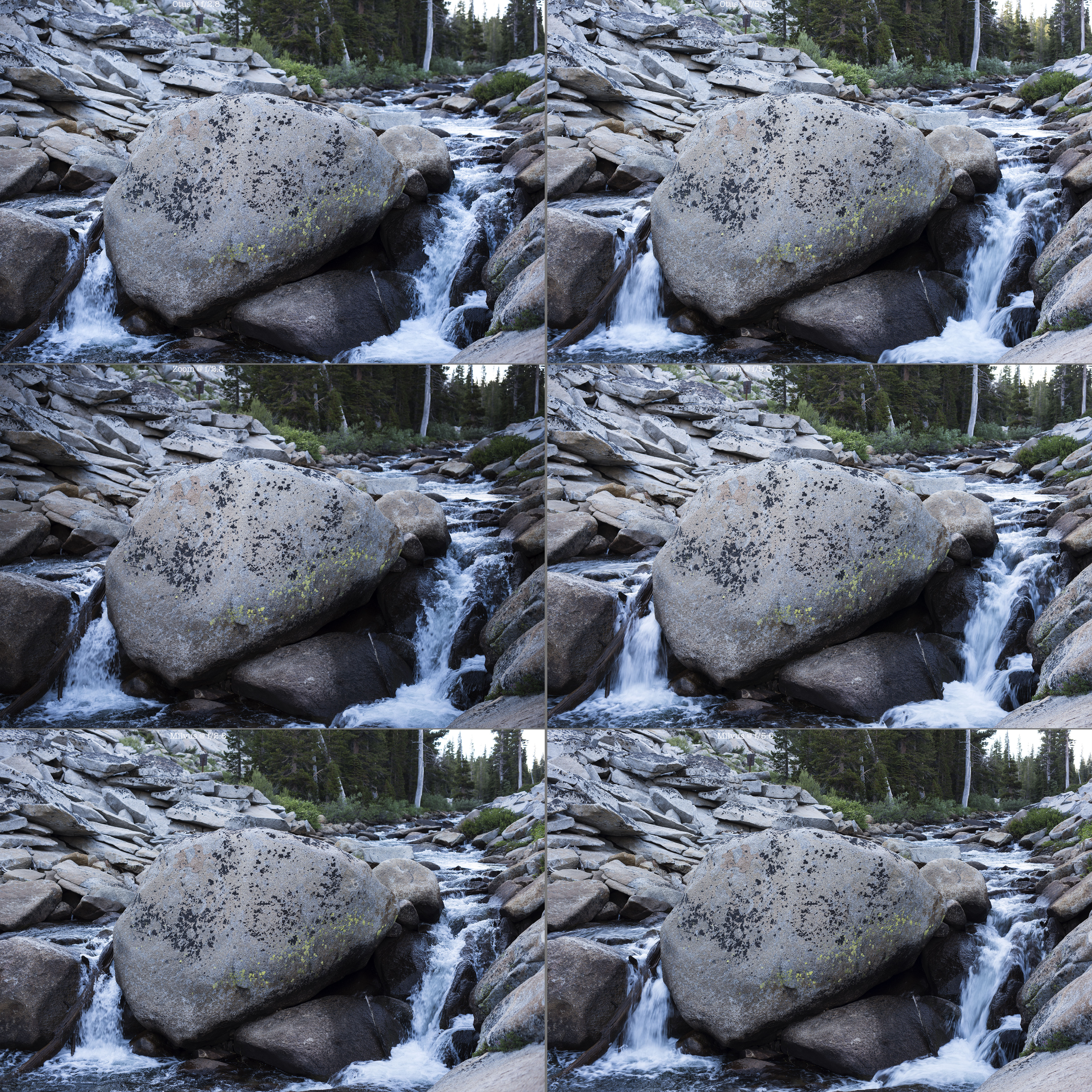
As seen below in the crop, the Nikon zoom is soft and hazy wide open at f/2.8; I observed this in Live View for this shot and every other shot in the ~50mm range—the Nikon zoom is not a strong performer wide open at 55mm—every zoom tends to have a weak area in the zoom range. That this not a focus error is proven by examining the boulder area closer and farther from this area as well as the same behavior with other series. The Otus and Milvus offers nice crisp micro contrast here. By f/5.6 the zoom cleans up its image considerably.

At bottom left, the Otus and Milvus perform well. The Nikon zoom, struggles even at f/5.6. Part of this may be caused by field curvature, but that is what is is: a handicap the forces stopping down more.
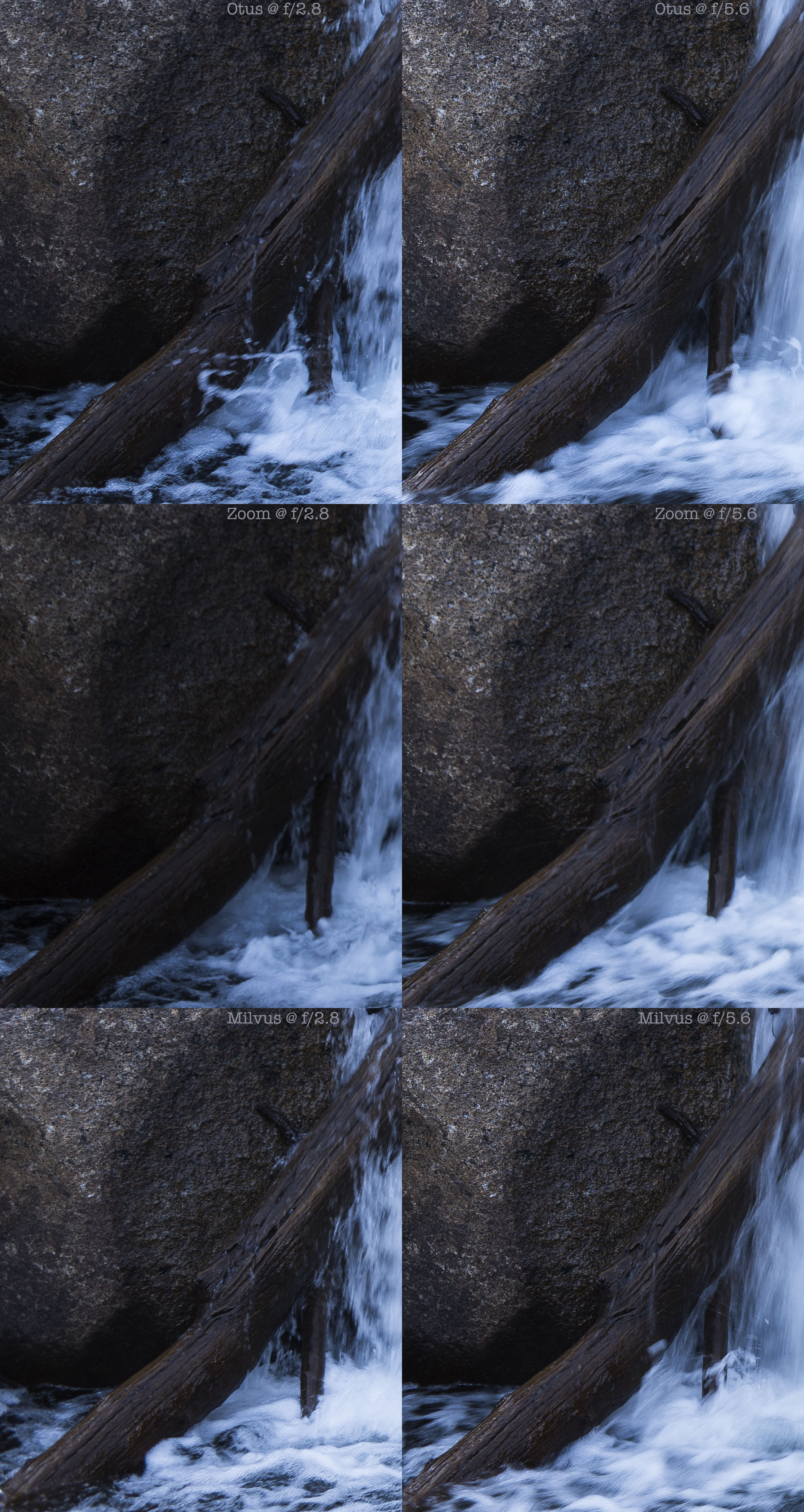
Example: Creek View to Half Dome (Nikon D810)
At reduced size, the images all look good. But there are very significant differences at the detail level.
The Otus 55/1.4 and Milvus 50/1.4 have even field illumination at f/2.8, being closed down two stops. The Nikon 24-70/2.8E zoom shows dark corners—see upper left and lower left in particular. Some vignetting wide open is unavoidable and it is well controlled in the zoom.
When I examined the entire image for each lens at full resolution, I found that all had some weakness looking somewhere in the frame; one cannot fixate on just one area. But when I look across the frame center/edges/corners/mid zones, the conclusion is clear: the Otus is hands down the best, the Milvus does nearly as well but its very extreme corners are weak until f/11, and the Nikon zoom struggles in the outer zones. While it appears that some of this struggle is field curvature, it has trouble even at bottom right, where it remains somewhat murky even at f/5.6.

Below, the Nikon zoom is soft wide open and the Zeiss Milvus 50/1.4 is also on the soft side. The Otus is already strong at f/2.8 and exemplary at f/5.6. The Nikon zoom and Milvus 50/1.4 improve nicely at f/5.6 but don’t have the “bite” of the Otus.
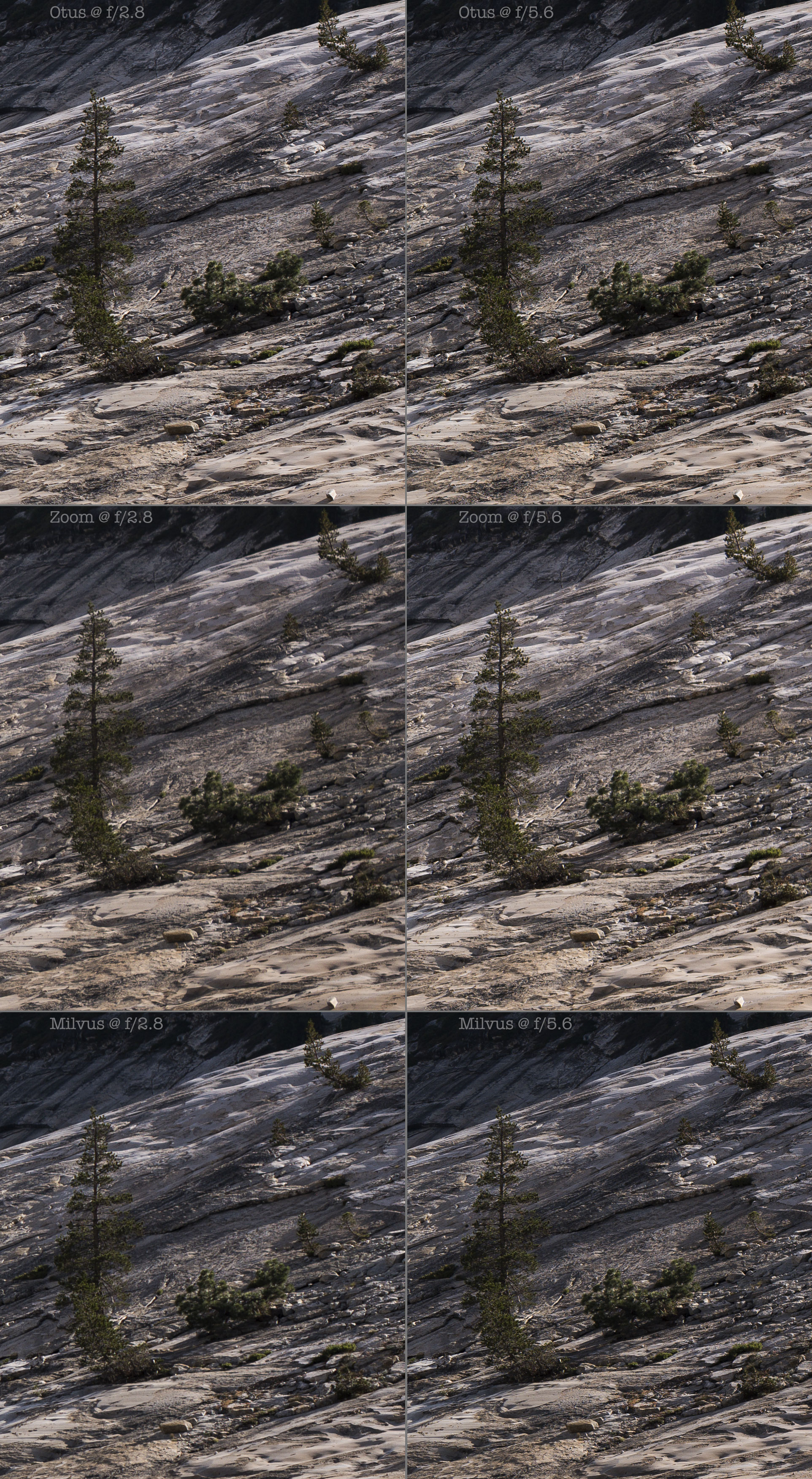
Field curvature can come into play and it probably does here—the Milvus is the best. But at f/5.6 the Otus and Milvus make a fine image. The Nikon zoom struggles and does not deliver a sharp image, even though this area is at the focusing distance.

At bottom right (far in front of the chosen focus in the distance, the Otus and Milvus deliver good contrast, but are not quite sharp (depth of field). The Nikon zoom is murky. Stopping down, the Otus and Milvus deliver strong results, but the zoom struggles, lacking fine detail.
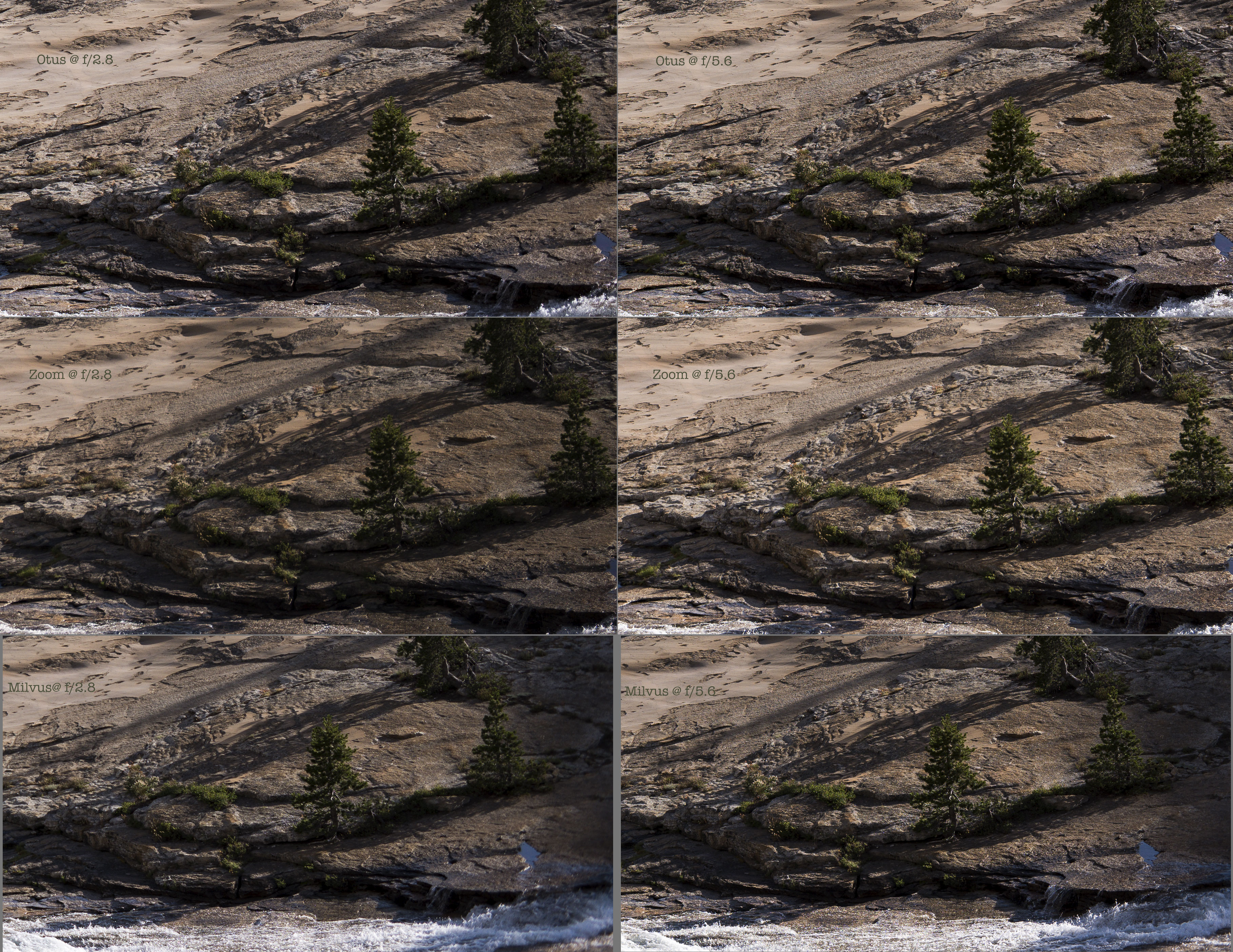
Example: Log House Front Entrance (Canon 5Ds R)
This example is slightly off kilter (not at 90° to house), done deliberately because the trees and shrubbery at right were of no use for seeing things. So the nominal plane of focus angles from slightly forward of the railing to slightly behind the railing.
This comparison shows f/2.8 and f/9: do the lenses “even out” or is there still a winning proposition that favors which lens(es)? For this example, I changed shooting position for the Zeiss Milvus 50mm f/1.4. Doing so changes perspective but get us closer to the same reproduction size. The Milvus 50/1.4 ZF.2 for Nikon was used with a lens adapter, which might have affected its performance at f/2.8 (no ZE version was available, and possibly the ZF.2 version is not optimal for the Canon sensor versus the ZE version).
Distortion is very hard to detect with a complex subject like this; a moot issue.
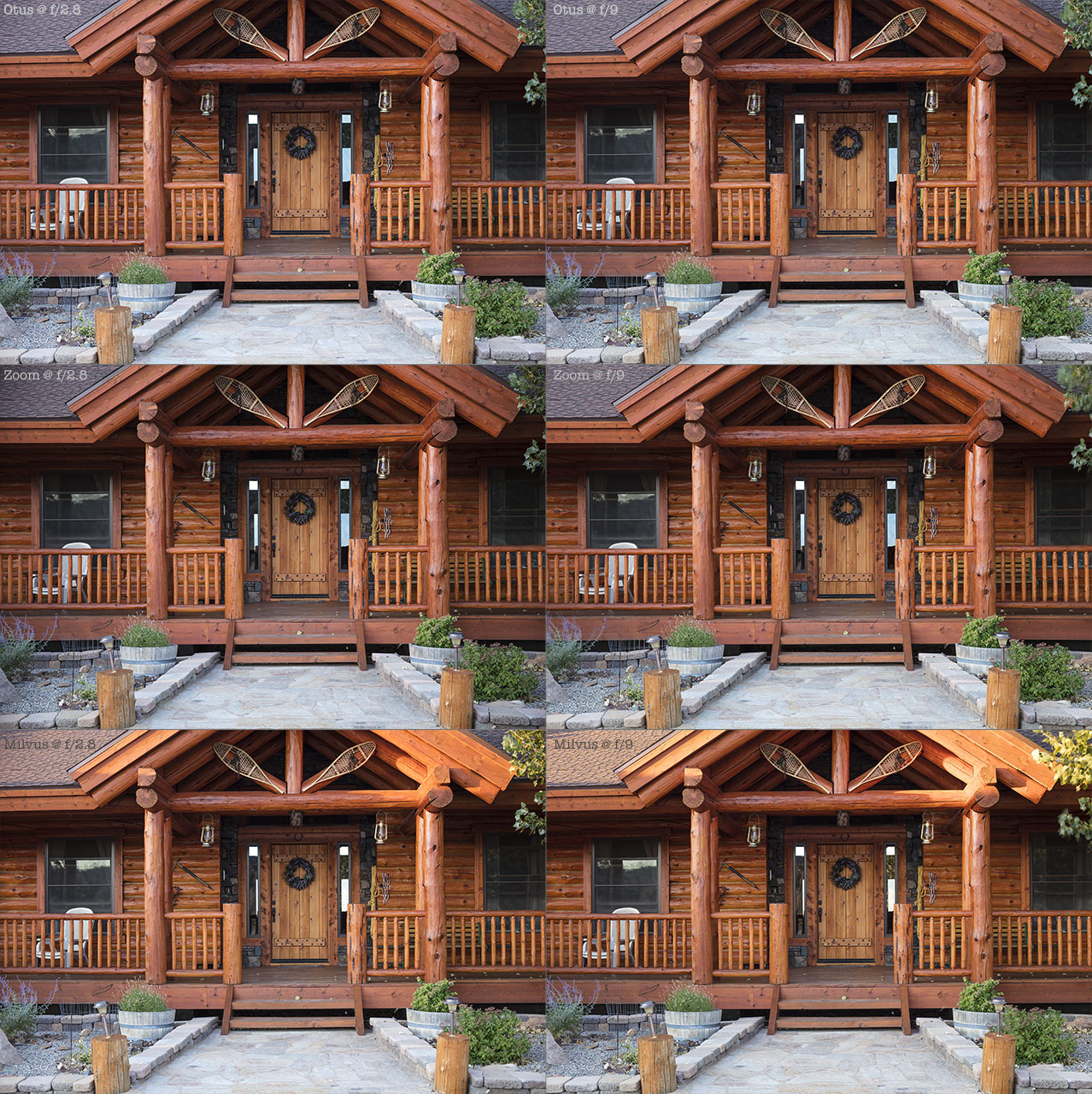
Below, the Otus delivers a solid image at f/2.8 with the best sharpness exending over the deepest zone (“real depth of field). The Milvus disappoints for unknown reasons (ZF.2 lens via lens adapter?), but its f/9 performance is superb. The Canon 24-70 does a fine job, but its zone of focus is a bit more forward; this may be a field curvature inflection point as this area is in the mid zone of the frame. That this is likely is supported by observing that the bottom of the door is much sharper than the top of the door (see the next crop)–and the tripod was dead-level.

Below, Otus and Milvus deliver a high grade image at f/9. The Canon 24-70 zoom leaves the door area substantially blurred, which is striking, since the bottom of the door is much sharper (previous crop). The likely explanation is an inflection in field curvature. The camera was dead-on level, so it is not an up/down angle consideration.
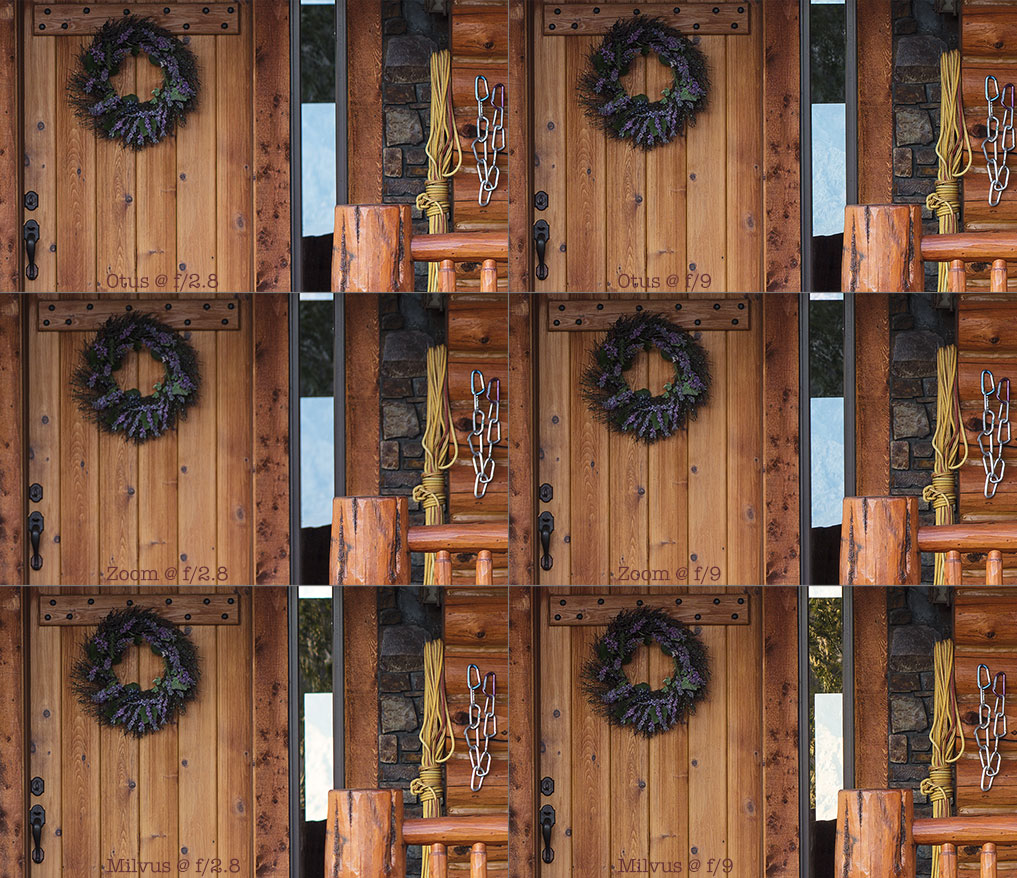
Corners are hard for lens performance. Often there is an increase in distortion and field curvature and astigmatism. As with the other crops it is important to view at full size to see the softness with the zoom.

Conclusions and recommendations
With a little stopping down, the Milvus 50/1.4 acquits itself very well against the Otus 55/1.4, and both primes have no trouble showing their mettle versus the zooms.
The differences seen in these comparisons are significant, but can be outweighed by other factors that tend to plague high resolution digital photography.
That first factor is focus accuracy, which is far harder than it sounds—placing the zone of focus optimally for the scene, which is not the same as focusing on one spot and assuming the focus will be ideal for that scene as a whole (given the intended final result). See Focusing Zeiss DSLR Lenses For Peak Performance PART TWO: Tips and Best Practices for Sharply Focused Images.
The second factor is lens performance built into the lens that cannot be controlled: sample variation and symmetry of performance across the frame. Prime lenses reduce the chances of such errors, but still they commonly occur. Zoom lenses, being much more complex, can vary in behavior across the zoom range and also interact with focusing distance—lots of moving parts (focusing and zooming). Thus in terms of the fewest compromises and best chance for consistent performance new out of the box and then over years of service, the prime lens tends to be the most reliable choice for peak performance.
Finally the issues of lens speed for low light shooting as well as greater versatility for subject separation from background mean that an f/1.4 prime lens offers a wider operating range and greater versatility for creative effect, whereas the zoom has some compromises but is much more versatile when one cannot walk off a cliff or back up through a wall. It’s why having both a zoom and a prime in the bag makes sense, even if the zoom covers the range of the prime.
Lloyd’s photography blog is found at diglloyd.com; it covers many brands, lenses, cameras. In-depth review coverage of the Zeiss DSLR lenses for Canon and Nikon is found in Guide to Zeiss DSLR Lenses. By subscription.
